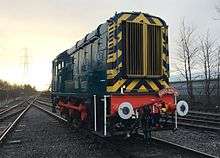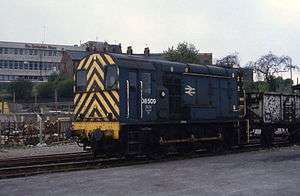British Rail Class 08
| British Rail Class 08 | |||||||||||||||||||||||||||||||||||||
|---|---|---|---|---|---|---|---|---|---|---|---|---|---|---|---|---|---|---|---|---|---|---|---|---|---|---|---|---|---|---|---|---|---|---|---|---|---|
|
08509 in Rail Blue livery at Chesterfield Goods Yard | |||||||||||||||||||||||||||||||||||||
| |||||||||||||||||||||||||||||||||||||
| |||||||||||||||||||||||||||||||||||||
| |||||||||||||||||||||||||||||||||||||
| |||||||||||||||||||||||||||||||||||||
The British Rail (BR) Class 08 is a class of diesel-electric shunting locomotive. The pioneer locomotive, number 13000, was built in 1952 although it did not enter service until 1953. Production continued until 1962; 996 locomotives were produced, making it the most numerous of all British locomotive classes.
As the standard BR general-purpose diesel shunter, the class became a familiar sight at major stations and freight yards. Since their introduction, though, the nature of rail traffic in Britain has changed considerably. Freight trains are now mostly fixed rakes of wagons, and passenger trains are mostly multiple units, neither requiring the attention of a shunting locomotive. Consequently, a large proportion of the class has been withdrawn from mainline use and stored, scrapped, exported or sold to industrial or heritage railways.
As of 2011, around 100 locomotives remain working on industrial sidings and on the main British network. On heritage railways, they have become common, appearing on many of the preserved standard-gauge lines in Britain, with over 60 preserved including the first one built.[1]
History
The Class 08 design was based on the LMS 12033 series (later TOPS Class 11) design. There were also 26 of the near-identical but higher-geared Class 09, and 171 similar locomotives fitted with different engines and transmissions (some of which became Class 10), which together brought the total number of outwardly-similar machines to 1193.
The locomotives were built at the BR Works of Crewe, Darlington, Derby, Doncaster and Horwich between 1952 and 1962.[2]
In 1985, three locomotives were reduced in height for use on the Burry Port and Gwendraeth Valley Railway in south west Wales, and became Class 08/9. The remainder of the class were reclassified as sub-class 08/0. A further two locomotives were converted to 08/9 in 1987.
The first locomotive to be withdrawn was D3193 in 1967. Four other machines were withdrawn before TOPS reclassification in 1973.[3] Withdrawals continued in subsequent decades until by the beginning of the 1990s most of the class were no longer in service.[4] At the same time as the withdrawals, many were purchased by heritage railways.
When British Rail was privatised and sold in the 1990s, EWS inherited most of the class. More units were disposed of, being sent to EWS's Component Recovery & Distribution Centre (CRDC) in Wigan for stripping of reusable components prior to scrapping. Others were stored in case of an increase in traffic.
In mid 2008, EWS had over 40 class 08 locomotives in operation, with a greater number stored. Freightliner also had about 5 locomotives in operation, as did locomotive company Wabtec. FirstGroup operated less than 5; additionally, some work at industrial sidings – 2 for Foster Yeoman, one for Mendip Rail, one for Corus, one at ICI Wilton, 2 for English China Clays, amongst others. A few other businesses in railway-related business operated single examples.[1]
Exported locomotives
Sixteen English Electric 060DE 350 hp locomotives based on the Class 11/Class 08 design, but modified for 1,600 mm (5 ft 3 in) gauge, were built new and exported 1951–53 to Australia, entering service on the Victorian Railways as the F class.
Five examples of the Class 08 were exported to Liberia; numbers: 3047, 3092, 3094, 3098 and 3100.[5] All five locos remain in Liberia and have been considerably robbed of parts in the intervening years [6]
Preserved railways
Continuing in its designed-for role as a shunter, the Class 08 has been found useful by numerous heritage railways in the UK. With over 70 examples preserved,[1] they are the second most numerous class of preserved locomotive in the UK.

Operations
As the standard general-purpose diesel shunter on BR, almost any duty requiring shunting would involve a Class 08; thus the many locations where 2 portions of a train were merged, or where additional stock was added to a train, were hauled (briefly) by a Class 08, thus the class was a familiar sight at many major stations and terminals.
Technical description
The Class 08 design was based on the LMS 12033 series (later TOPS Class 11) design.
The engine is an English Electric (EE) 6 cylinder, 4-stroke, 6KT. Traction motors are 2 EE 506 motors with double reduction gear drive. The main generator is an EE 801.
Design variations
There were variations on the basic design, which were given the following TOPS design codes:
| TOPS design code | Electrical system | Max speed | Weight | Brakes | Route availability | Notes |
|---|---|---|---|---|---|---|
| 08-0AV | 90 V | 20 mph (32 km/h) | 49.8 te (496 kN) | vacuum | 5 | |
| 08-0BX | 110 V | 20 mph (32 km/h) | 50.4 te (502 kN) | dual | 5 | |
| 08-0CA | 90 V | 20 mph (32 km/h) | 49.6 te (494 kN) | air | 5 | |
| 08-0DV | 90 V | 15 mph (24 km/h) | 49.8 te (496 kN) | vacuum | 5 | |
| 08-0BX | 90 V | 15 mph (24 km/h) | 50.4 te (502 kN) | dual | 5 | |
| 08-0FA | 90 V | 15 mph (24 km/h) | 49.6 te (494 kN) | air | 5 | |
| 08-0KX | 110 V | 15 mph (24 km/h) | 50.4 te (502 kN) | dual | 5 | |
| 08-0LX | 110 V | 15 mph (24 km/h) | 50.4 te (502 kN) | dual | 5 | Scharfenberg adapter fitted |
| 08-0MA | 110 V | 15 mph (24 km/h) | 49.8 te (496 kN) | air | 5 | |
| 08-0NA | 90 V | 15 mph (24 km/h) | 49.8 te (496 kN) | air | 5 | fitted with Buckeye couplings |
| 08-0PA | 90 V | 15 mph (24 km/h) | 51 te (508 kN) | air | 6 | fitted with Buckeye couplings |
| 08-0QA | 90 V | 15 mph (24 km/h) | 51 te (508 kN) | air | 6 | fitted with Buckeye couplings |
| 08-0RA | 110 V | 15 mph (24 km/h) | 51 te (508 kN) | air | 6 | fitted with Buckeye couplings |
| 08-0SA | 110 V | 15 mph (24 km/h) | 49 te (488 kN) | air | 6 |
Class 08/9
Class 08/9 locomotives were modified from the standard class by being given headlights and cut-down bodywork in which the overall height was reduced to 11’ 10" (3.61 m), for use on the Burry Port and Gwendraeth Valley Railway up to Cwm Mawr. In 2007, a few of these locomotives were used on the Manchester Metrolink track relaying project. Their job was to take the track to the construction sites.
| TOPS design code | Electrical system | Max speed | Weight | Brakes | Notes |
|---|---|---|---|---|---|
| 08-9AV | 90 V | 15 mph (24 km/h) | 49.8 te (496 kN) | vacuum brakes | 08 991 converted from 08 203 |
| 08-9CX | 90 V | 15 mph (24 km/h) | 50.4 te (502 kN) | dual brakes | 08 992 created from 08 259 08 993 created from 08 592 |
| 08-9DA | 90 V | 15 mph (24 km/h) | 49.6 te (494 kN) | air brakes | 08 994 created from 08 462 08 995 created from 08 687 |
BR Class 13
6 Class 08 units were adapted for a specialist role at Tinsley Marshalling Yard, where there was a requirement for more powerful shunters. These locomotives were permanently coupled together in pairs as a 'master and slave' (or 'cow and calf'), the latter with its cab removed, to form the British Rail Class 13. A total of 3 were made and all have since been scrapped.
Fleet
| TOPS number range | Operators | Comments |
|---|---|---|
| 08389, 08405, 08428, 08441, 08495, 08500, 08511, 08567, 08578, 08580, 08593, 08605, 08623, 08630, 08632, 08633, 08653, 08676, 08683, 08703, 08706, 08709, 08714, 08735, 08737, 08752, 08765, 08784, 08799, 08802, 08804, 08865, 08879, 08886, 08888, 08904, 08905, 08907, 08909, 08924, 08951, 08993, 08994, | DB Cargo UK | |
| 08571, 08596, 08615 | Virgin Trains East Coast | |
| 08943 | Harry Needle Railroad Company | |
| 08525, 08690, 08908, 08950 | East Midlands Trains | |
| 08077, 08530, 08531, 08575, 08585, 08624, 08691, 08764, 08785, 08891 | Freightliner | |
| 08948 | Eurostar | |
| 08410, 08483, 08641, 08643, 08644, 08663, 08795, 08822, 08836 | Great Western Railway | |
| 08616, 08805 | London Midland | |
| 08754 & 08847 (Norwich Crown Point TMD), 08573 (Ilford TMD) | Abellio Greater Anglia | |
| 08417 | Network Rail | |
| 08502 | Northern | |
| 08308, 08788 | Abellio ScotRail | |
| 08451, 08454, 08611, 08696, 08721, 08790, 08887, 08934 | Virgin Trains | |
| 08418, 08485, 08678 | West Coast Railway Company | |
| 08682 | Derby Carriage and Wagon Works |
Models
Several manufacturers have produced models of Class 08 shunters. In OO scale, Wrenn, Tri-ang, Hornby Railways and Bachmann Branchline all produced models. Lima also produced a model in several different liveries, but it was of the near-identical Class 09.
Since 2000, both Bachmann Branchline and Hornby have released much more detailed models, in a variety of liveries and with a variety of appropriate detail variations.
In British N Gauge, Graham Farish have also produced 2 versions; a relatively crude version lacking outside frames that was discontinued in 2007, and a more detailed version with outside frames that was unveiled 2008.[7]
In fiction
The Class 08 locomotives were the basis for the character Diesel in The Railway Series books written by the Rev. W. Awdry, and the subsequent Thomas the Tank Engine and Friends TV Series. The Class 08 has also provided the basis Splatter & Dodge (Splodge), Arry & Bert, Paxton, and Sidney in the series.
References
- 1 2 3 Fleet status (subsection Class 01-14) wnxx.net Archived 20 October 2007 at the Wayback Machine.
- ↑ Marsden, Colin J. (1981). The Diesel Shunter – A Pictorial Record. Oxford: Oxford Publishing. ISBN 978-0-86093-108-9.
- ↑ Disposals Class 08 wnxx.com
- ↑ Locomotive Disposals Class 08 (see also subsequent pages) wnxx.com
- ↑ A brief look at the diesel locomotives built by Derby Locomotive Works from 1932–1967 derbysulzers.com
- ↑ June 2010 Update
- ↑ Farish Class 08 diesel shunter emerges at Redhill bachmann.co.uk
Further reading
- Lund, E (1980). To the last drop. Chesterfield: Longden technical Publications. ISBN 0-9507063-0-2.
- Williams, Alan; Percival, David (1977). British Railways Locomotives and Multiple Units including Preserved Locomotives 1977. Shepperton: Ian Allen Ltd. ISBN 0-7110-0751-9.
- "D3002 saved". Rail Enthusiast. EMAP National Publications. September 1982. p. 58. ISSN 0262-561X. OCLC 49957965.
- Cooper, Basil (March 1983). "What's in an 08?". Rail Enthusiast. EMAP National Publications. pp. 12–13. ISSN 0262-561X. OCLC 49957965.
External links
| Wikimedia Commons has media related to British Rail Class 08. |
